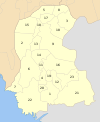24°55′53″N 67°02′15″E / 24.9313°N 67.0374°E
Karachi Nazimabad District
ضلع ناظم آباد کراچی | |
|---|---|
 Nagan Interchange in North Nazimabad | |
 Map of Nazimabad District | |
| Country | |
| Province | |
| Division | Karachi |
| Established | 1996 |
| Re-established | 11 July 2011 |
| Headquarters | DC Office, Sector 15-A/1, Buffer Zone |
| Towns[1] | |
| Government | |
| • Deputy Commissioner | Fawad Soomro[2] |
| Area | |
| • Total | 69 km2 (27 sq mi) |
| Population | |
| • Total | 3,822,325 |
| • Density | 55,000/km2 (140,000/sq mi) |
| Website | dmccentral |
Nazimabad District (Urdu: ضلع ناظم آباد ), formerly Karachi Central District, is an administrative district of Karachi Division in Sindh, Pakistan.
History

The district was abolished in 2000 and divided into four towns namely Gulberg Town, Liaquatabad Town, New Karachi Town, and North Nazimabad Town.[4]
On 11 July 2011, the Government of Sindh restored Karachi Central District again.[5]
Karachi Central District has the following dehs: Gujhro (P), in the talukas of Gulberg and Liaquatabad, and Kari Lakhi, in the taluka of North Nazimabad.
In 2022, it was divided into five towns namely Gulberg Town, Liaquatabad Town, Nazimabad Town, New Karachi Town, and North Nazimabad Town respectively.
In 2023, the Government of Sindh renamed Karachi Central District to Nazimabad District to align with its famous town name.[6]
Union committees
The following is a list of the union councils of Nazimabad District, and their respective neighbourhoods and suburban localities. Nazimabad District has a total of five towns and 45 union councils.[7]
Gulberg Town
| Union Council |
|---|
| U.C. 1 Shafiq Mill Colony |
| U.C. 2 Samanabad |
| U.C. 3 Water Pump |
| U.C. 4 Naseerabad |
| U.C. 5 Yaseenabad |
| U.C. 6 Azizabad |
| U.C. 7 Karimabad |
| U.C. 8 Gulberg |
Liaquatabad Town
| Union Council |
|---|
| U.C. 1 Moosa Colony |
| U.C. 2 Sharifabad |
| U.C. 3 Bandhani Colony |
| U.C. 4 Ibn-e-Seena |
| U.C. 5 Commercial Area |
| U.C. 6 Dak Khana |
| U.C. 7 C-Area |
Nazimabad Town
| Union Council |
|---|
| U.C. 1 Paposh Nagar |
| U.C. 2 Abbasi Shaheed |
| U.C. 3 Hadi Market |
| U.C. 4 Nazimabad |
| U.C. 5 Rizvia Society (R.C.H.S.) |
| U.C. 6 Firdous Colony |
| U.C. 7 Gulbahar |
New Karachi Town
| Union Council |
|---|
| U.C. 1 Shah Nawaz Bhutto Colony |
| U.C. 2 Gulshan-e-Saeed |
| U.C. 3 Khawaja Ajmeer Nagri |
| U.C. 4 Godhra |
| U.C. 5 Abu Zar Ghaffari |
| U.C. 6 Khamiso Goth |
| U.C. 7 Madina Colony |
| U.C. 8 Faisal Colony |
| U.C. 9 Abu Zar Ghaffari |
| U.C. 10 Godhra |
| U.C. 11 Hakim Ahsan |
| U.C. 12 Kailana |
| U.C. 13 Shah Nawaz Bhutto Colony |
North Nazimabad Town
| Union Council |
|---|
| U.C. 1 Sir Syed Colony |
| U.C. 2 Farooq-e-Azam |
| U.C. 3 Siddiq-e-Akbar |
| U.C. 4 Buffer Zone |
| U.C. 5 Taimooria |
| U.C. 6 Sakhi Hassan |
| U.C. 7 Hyderi |
| U.C. 8 Al-Falah |
| U.C. 9 Pahar Gunj |
| U.C. 10 Mustafaabad |
Demographics
At the time of the 2017 census, Nazimabad district had 534,192 households and a population of 2,971,382. Nazimabad had a sex ratio of 900 females per 1000 males and a literacy rate of 81.52%: 81.90% for males and 81.13% for females. The entire population lived in urban areas. 627,927 (21.13%) were under 10 years of age.[8] In 2023, the district had 652,776 households and a population of 3,822,325.[9]
The majority religion is Islam, with 98.31% of the population. Christianity is practiced by 1.22% of the population.[8]
At the time of the 2017 census, 70.77% of the population spoke Urdu, 6.57% Punjabi, 5.53% Pashto, 5.44% Saraiki, 2.57% Sindhi, and 1.41% Hindko as their first language.[8]
References
- ^ Tahir Siddiqui (8 January 2022). "Division of Karachi into 26 towns, 233 UCs notified (by the government)". Dawn (newspaper). Retrieved 17 January 2022.
- ^ "CM says deadly fire criminal negligence of SBCA". The Nation (newspaper). 8 December 2023. Retrieved 19 December 2023.
- ^ "PROVINCE WISE PROVISIONAL RESULTS OF CENSUS - 2017" (PDF). Pakistan Bureau of Statistics. 2017. p. 12.
- ^ "Districts - Commissioner Karachi Division". Commissioner Karachi Division. Retrieved 12 October 2021.
- ^ "Sindh back to 5 divisions after 11 years". Pakistan Today (newspaper). 11 July 2011. Retrieved 12 October 2021.
- ^ "Four Karachi districts to be renamed". 29 March 2024. Retrieved 4 April 2024.
- ^ "Division of UCs in Karachi - Notification" (PDF). lgdsindh.gov.pk. Local Government & Housing Town Planning Department – Government of Sindh. 27 April 2023. Retrieved 29 December 2023.
- ^ a b c d "District Wise Results / Tables (Census - 2017)". www.pbscensus.gov.pk. Pakistan Bureau of Statistics.
- ^ "TABLE 1 : HOUSEHOLDS, POPULATION, HOUSEHOLD SIZE AND ANNUAL GROWTH RATE" (PDF). www.pbscensus.gov.pk. Pakistan Bureau of Statistics. 2023.

